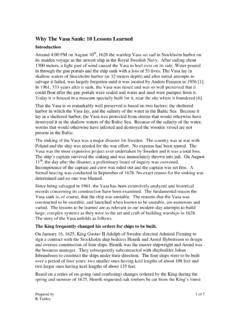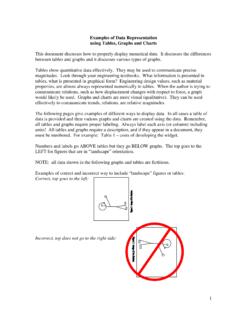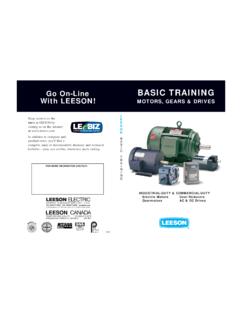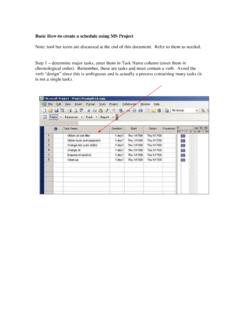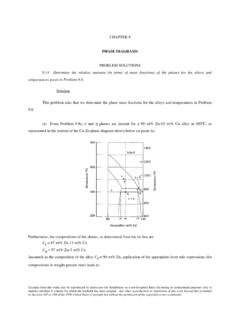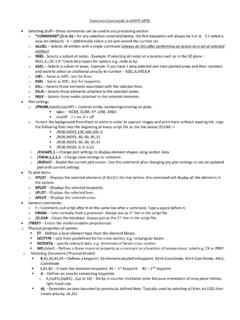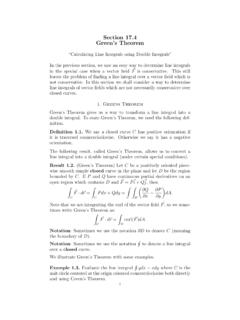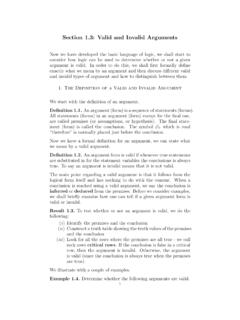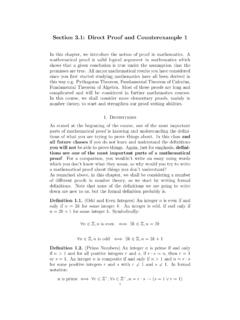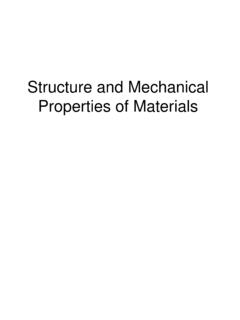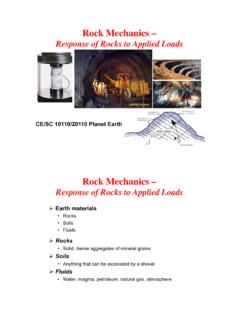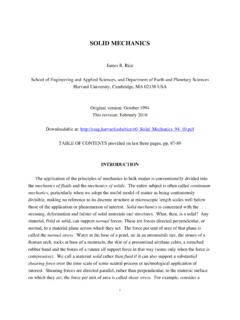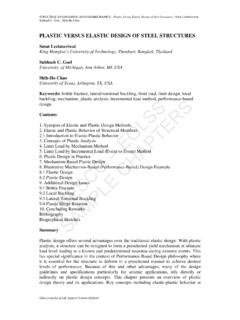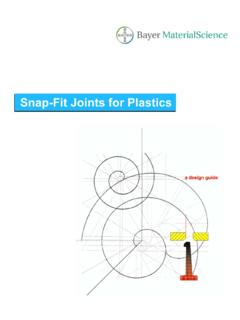Transcription of Stress-Strain Behavior
1 Stress-Strain Behavior A specimen of aluminum having a rectangular cross section 10 mm mm ( in. in.) is pulled in tension with 35,500 N (8000 lbf) force, producing only elastic deformation . Calculate the resulting strain. Solution This problem calls for us to calculate the elastic strain that results for an aluminum specimen stressed in tension. The cross-sectional area is just (10 mm) ( mm) = 127 mm2 (= 10-4 m2 = ); also, the elastic modulus for Al is given in Table as 69 GPa (or 69 109 N/m2). Combining Equations and and solving for the strain yields = E=FA0E= 35,500N( 10 4m2)(69 109 N/m2)= 10-3 A steel bar 100 mm ( in.) long and having a square cross section 20 mm ( in.)
2 On an edge is pulled in tension with a load of 89,000 N (20,000 lbf), and experiences an elongation of mm ( 10-3 in.). Assuming that the deformation is entirely elastic, calculate the elastic modulus of the steel. Solution This problem asks us to compute the elastic modulus of steel. For a square cross-section, A0 = b02, where b0 is the edge length. Combining Equations , , and and solving for E, leads to E = = FA0 ll0= Fl0b02 l = (89, 000 N)(100 10 3m)(20 10 3m)2( 10 3m) = 223 109 N/m2 = 223 GPa ( 106 psi) For a bronze alloy, the stress at which plastic deformation begins is 275 MPa (40,000 psi), and the modulus of elasticity is 115 GPa ( 106 psi). (a) What is the maximum load that may be applied to a specimen with a cross-sectional area of 325 mm2 ( ) without plastic deformation ?
3 (b) If the original specimen length is 115 mm ( in.), what is the maximum length to which it may be stretched without causing plastic deformation ? Solution (a) This portion of the problem calls for a determination of the maximum load that can be applied without plastic deformation (Fy). Taking the yield strength to be 275 MPa, and employment of Equation leads to Fy = yA0 = (275 106 N/m2)(325 10-6 m2) = 89,375 N (20,000 lbf) (b) The maximum length to which the sample may be deformed without plastic deformation is determined from Equations and as li = l01+ E = (115 mm) 1+275 MPa115 103 MPa = mm ( in.) Elastic Properties of Materials A cylindrical specimen of aluminum having a diameter of 19 mm ( in.)
4 And length of 200 mm ( in.) is deformed elastically in tension with a force of 48,800 N (11,000 lbf). Using the data contained in Table , determine the following: (a) The amount by which this specimen will elongate in the direction of the applied stress. (b) The change in diameter of the specimen. Will the diameter increase or decrease? Solution (a) We are asked, in this portion of the problem, to determine the elongation of a cylindrical specimen of aluminum. Combining Equations , , and , leads to = E F d024 =E ll0 Or, solving for l (and realizing that E = 69 GPa, Table ), yields l = 4F l0 d02E = (4)(48,800 N)(200 10 3m)( )(19 10 3m)2(69 109N / m2)=5 10-4 m = mm ( in.) (b) We are now called upon to determine the change in diameter, d.
5 Using Equation = x z= d/d0 l/l0 From Table , for aluminum, = Now, solving the above expression for d yields d = ld0l0= ( )( mm)(19 mm)200 mm = 10-2 mm ( 10-4 in.) The diameter will decrease. A cylindrical specimen of a hypothetical metal alloy is stressed in compression. If its original and final diameters are and mm, respectively, and its final length is mm, compute its original length if the deformation is totally elastic. The elastic and shear moduli for this alloy are 105 GPa and GPa, respectively. Solution This problem asks that we compute the original length of a cylindrical specimen that is stressed in compression. It is first convenient to compute the lateral strain x as x = dd0= mm mm= 10-3 In order to determine the longitudinal strain z we need Poisson's ratio, which may be computed using Equation ; solving for yields =E2G 1 = 105 103 MPa(2)( 103 MPa) 1 = Now z may be computed from Equation as z = x = 10 10-3 Now solving for l0 using Equation l0 = li1+ z = mm1 10 3= mm A brass alloy is known to have a yield strength of 275 MPa (40,000 psi), a tensile strength of 380 MPa (55,000 psi), and an elastic modulus of 103 GPa ( 106 psi).
6 A cylindrical specimen of this alloy mm ( in.) in diameter and 250 mm ( in.) long is stressed in tension and found to elongate mm ( in.). On the basis of the information given, is it possible to compute the magnitude of the load that is necessary to produce this change in length? If so, calculate the load. If not, explain why. Solution We are asked to ascertain whether or not it is possible to compute, for brass, the magnitude of the load necessary to produce an elongation of mm ( in.). It is first necessary to compute the strain at yielding from the yield strength and the elastic modulus, and then the strain experienced by the test specimen. Then, if (test) < (yield) deformation is elastic, and the load may be computed using Equations and However, if (test) > (yield) computation of the load is not possible inasmuch as deformation is plastic and we have neither a Stress-Strain plot nor a mathematical expression relating plastic stress and strain.
7 We compute these two strain values as (test) = ll0= mm250 mm= and (yield) = yE=275 MPa103 103 MPa= Therefore, computation of the load is not possible since (test) > (yield). Tensile Properties Figure shows the tensile engineering stress strain Behavior for a steel alloy. (a) What is the modulus of elasticity? (b) What is the proportional limit? (c) What is the yield strength at a strain offset of (d) What is the tensile strength? Solution Using the Stress-Strain plot for a steel alloy (Figure ), we are asked to determine several of its mechanical characteristics. (a) The elastic modulus is just the slope of the initial linear portion of the curve; or, from the inset and using Equation E = 2 1 2 1=(200 0) MPa( 0)= 200 103 MPa = 200 GPa ( 29 106 psi) The value given in Table is 207 GPa.
8 (b) The proportional limit is the stress level at which linearity of the Stress-Strain curve ends, which is approximately 300 MPa (43,500 psi). (c) The strain offset line intersects the Stress-Strain curve at approximately 400 MPa (58,000 psi). (d) The tensile strength (the maximum on the curve) is approximately 515 MPa (74,700 psi). A load of 85,000 N (19,100 lbf) is applied to a cylindrical specimen of a steel alloy (displaying the stress strain Behavior shown in Figure ) that has a cross-sectional diameter of 15 mm ( in.). (a) Will the specimen experience elastic and/or plastic deformation ? Why? (b) If the original specimen length is 250 mm (10 in.), how much will it increase in length when this load is applied?
9 Solution This problem asks us to determine the deformation characteristics of a steel specimen, the Stress-Strain Behavior for which is shown in Figure (a) In order to ascertain whether the deformation is elastic or plastic, we must first compute the stress, then locate it on the Stress-Strain curve, and, finally, note whether this point is on the elastic or plastic region. Thus, from Equation =FA0=85,000 N 15 10 3m2 2= 481 106 N/m2 = 481 MPa (69, 900 psi) The 481 MPa point is beyond the linear portion of the curve, and, therefore, the deformation will be both elastic and plastic. (b) This portion of the problem asks us to compute the increase in specimen length. From the Stress-Strain curve, the strain at 481 MPa is approximately Thus, from Equation l = l0= ( )(250 mm) = mm ( in.)
10 A cylindrical metal specimen having an original diameter of mm ( in.) and gauge length of mm ( in.) is pulled in tension until fracture occurs. The diameter at the point of fracture is mm ( in.), and the fractured gauge length is mm ( in.). Calculate the ductility in terms of percent reduction in area and percent elongation. Solution This problem calls for the computation of ductility in both percent reduction in area and percent elongation. Percent reduction in area is computed using Equation as %RA = d02 2 df2 2 d02 2 100 in which d0 and df are, respectively, the original and fracture cross-sectional areas. Thus, %RA = mm2 2 mm2 2 mm2 2 100 = While, for percent elongation, we use Equation as %EL =lf l0l0 100 = mm mm 100 = 42% Elastic Recovery After Plastic deformation A cylindrical specimen of a brass alloy mm ( in.)
